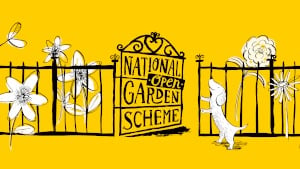About 35 Digswell Road
Our suburban garden of around a third of an acre (or 1300 square metres), close to the town centre, is fortunate to have a wonderful natural setting, with its backdrop of mature trees on its northern and western sides, and a more open aspect on its southern side. High hedges give a sense of enclosure as well as privacy. As with most residential gardens, we suspect, our garden has evolved over many years.
There has been no grand design, but simply an overriding wish to concentrate on plants, chosen and planted to create a particular effect and atmosphere in the garden. As a deliberate decision on our part, the garden has very little hard landscaping, sculptures or other garden ornamentation. Despite more recent gardening trends we still have a traditional large lawn, for the very good reason – we like it, and of course it sets off the planting extremely well!
There have been two influences on the style of planting. The more important one resulted from a visit in September 2000 to a specialist nursery near Potters Bar, not far away. On display was a wonderful selection of flowering grasses, which swayed and shimmered in the early autumn sunshine. The nursery owner showed me the book “Gardening with Grasses” by Piet Oudolf, the eminent Dutch garden designer, and introduced me to Oudolf’s naturalistic planting style – also known as prairie planting. This style has become the dominating influence in our garden. In his gardens Oudolf uses carefully chosen hardy perennials, mostly modern selections of robust wilder looking plants, and grasses. In his larger schemes these are often planted in large blocks or flowing drifts of colour.
We have visited many of Oudolf’s gardens in the UK; also, in late summer 2006 we visited his private garden in Hummelo in Holland, which was truly inspiring. Many of his signature plants can now be found in our garden. The second influence is our travels abroad, particularly to North and South America, Africa and Asia, where it has been exciting to see exotic plants in their natural habitats. Having seen such wonderful plants, we found the urge to grow just a few of them in our garden irresistible. Inevitably, there have been failures as well as surprising successes. The garden therefore attempts to combine these two influences, hopefully in a way which is harmonious and pleasing – but also consistent with the overall style of the garden and its natural surroundings.
The lawn at the rear of the house is surrounded by herbaceous borders full of tall perennial plants and grasses, planted in a contemporary naturalistic style. Further from the house behind a tightly clipped conifer hedge the garden has a small scale perennial meadow – and the introduction of more exotic plants, such as rhododendrons, camellias, trachycarpus, astelias, tetrapanax and a large cordyline. There is also a small cactus and succulent bed. At the far end of the garden under the canopy of mature trees there is a jungle garden containing lush foliage plants such as palms, tree ferns, bananas, bamboos and other unusual less hardy exotics.
.
Website:
https://www.adriansgarden.org
.jpg)
.jpg)
.jpg)
.jpg)
.jpg)
.jpg)
.jpg)
.jpg)
.jpg)
.jpg)
.jpg)
.jpg)
.jpg)
.jpg)
.jpg)
.jpg)
.jpg)
.jpg)


.jpg)

.jpg)
.jpg)
.jpg)
.jpg)
.jpg)